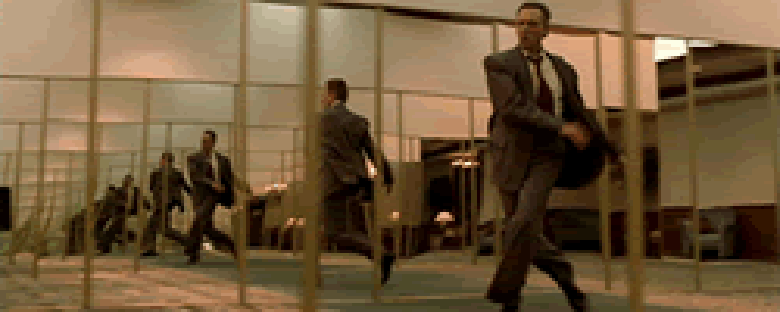Credits
Feature by: Rumsey Taylor
Posted on: 26 September 2004
Related articles:
features: The Work of Director Chris Cunningham
features: The Work of Director Michel Gondry
External links:
Spike Jonze (under the misnomer Richard Koufey) is flanked by his Torrance Community Dance Group, on the busy streets of New York City on the day prior to a performance at the 1999 MTV Video Music Awards. Complete in coordinated sweatpants and t-shirt, Jonze approaches a group surrounding an active boombox and makes a genial introduction. “Wanna go head-to-head, me and you?” What transpires between Jonze’s feigned dance group and an actual b-boy posse (reminiscent, perhaps, of one Koufey claims to have been educated by) summates the career of the vanguard music video director: it is innocent, devoid of any judgment or racial concern, and thoroughly hilarious.
To further illustrate this innocence is Spike’s video for the Notorious B.I.G.’s Sky’s The Limit: it complements a rap song in the expected fashion, replete with female dancers in bathing suits and immersed in an affluent setting. According to these credits alone, the video is a carefully emulative gesture, and belongs in a music genre categorized visually by sexism and violence – these criticisms Jonze avoids by populating the video entirely with children. It is a total irony.
In the past decade perhaps no director has sprung from the music video medium with the immediate critical acknowledgement Jonze has received, earning an Oscar nomination for direction with his debut feature Being John Malkovich. (His peers David Fincher, Mark Romanek, and Michel Gondry, I should note, have also crossed-over.) Taken from its success, Being John Malkovich is a cumulative effort in a career of regular creativity that possesses many comparatively diminutive and equally radiant gems.
Jonze (né Spiegel, of Spiegel catalogue renown) possesses routine and impeccable variety in his work: the loose documenting of the Beastie Boys’ Sure Shot is a stark difference to the technical precision of the Pharcyde’s Drop or Wax’s California. These three videos alone, in a career of nearly forty, exhibit the extents of a range Jonze has cumulatively illustrated.
Palm Pictures’ issue of Spike Jonze’s work contains sixteen of his music videos, complete with commentary and interview footage with a slew of affiliates. Additionally, the set contains some short form work, of note: How They Got There is a humorous pantomime that results in harm; The Oasis Video That Never Happened contains clips of Brits as they listen to an Oasis single, and their ideas for a video treatment; Rockafella Skank is noticeably evocative of Jonze’s future clip for Praise You, and involves the director dancing to the song before an involuntary Los Angeles crowd; Torrance Rises documents the Torrance Community Dance Group’s rehearsals, performance, and wins at the 1999 MTV Video Music Awards; and finally, Jonze’s Amarillo By Morning is an uncharacteristically sympathetic and interested gesture. The film documents teens Jonze met at a Texas rodeo. They are alienated from their peers, and strongly aspire to be cowboys.
In commentaries and supplemental footage the technical ccomplishments California and Drop are explained. Formidably, the former is conducted exactingly in a single, twelve second shot, the latter completely in reverse, requiring the artists to memorize their own song phonetically backwards (proportionally, this is Twin Peak’s signature dream sequence with a higher speed and duration).
In addition to his technical exercises, two of Jonze’s works included here are thematic masterpieces. Daft Punk’s Da Funk, the group’s first video, is a narrative involving a midwestener in his first month in New York City. He is alienated and nostalgic, and genuinely interested in fitting in. Notably, this character’s strife is visually evoked in a prosthetic dog’s head. There is an obvious humor to the scenario, but it is a work of genuine desperation. The clip contains an enormously suggestive detail: notice how the dogboy is distracted looking through his wallet by an old photograph; in it, the brief image of a female with a dog’s head. She is a source of comfort, apparently lost and disconnected. The masterpiece presages a similar desire for belonging exhibited in Malkovich.
Much subtler although comparably essential is Jonze’s clip for The Chemical Brothers’ Elektrobank, with his girlfriend (and now wife) Sofia Coppola in the role of a pressured gymnast. The music irregularly accompanies her dance routine, seen is activity that pressures her: the glare of hate from an opposing gymnast, her father in the gymnasium bleachers, and her mother’s late entry with an unfamiliar boyfriend in tow. An entire teenage strife is told and resolute in four minutes.
Jonze’s clip for Fatboy Silm’s Praise You is arguably his most artful collaboration. It is low-fi cinematography and amateur choreography, a mocking – and exceptional – emulation of the very concept that characterizes hundreds of music videos. It is an instance in which the musician’s selfless disregard (although Norman Cook makes a cameo) and sense of humor is required. Appropriately, these traits characterize many of Jonze’s collaborations. In this medium renowned for generic marketing integrity, Jonze’s work disenables such implicit dismissal.
We don’t do comments anymore, but you may contact us here or find us on Twitter or Facebook.



